Upton's Hill
Introduction
Text-to-speech Audio
Images
Fort Ramsay at Upton's Hill on an 1865 US War Department map of Washington, D.C.
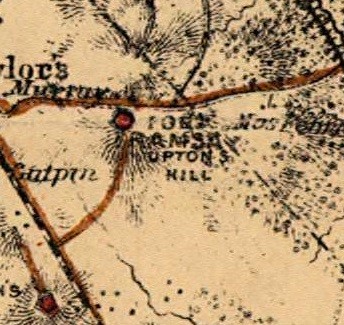
A "Quaker gun" in Centreville, Virginia, in March 1862; the man in the picture is pretending to "fire" it
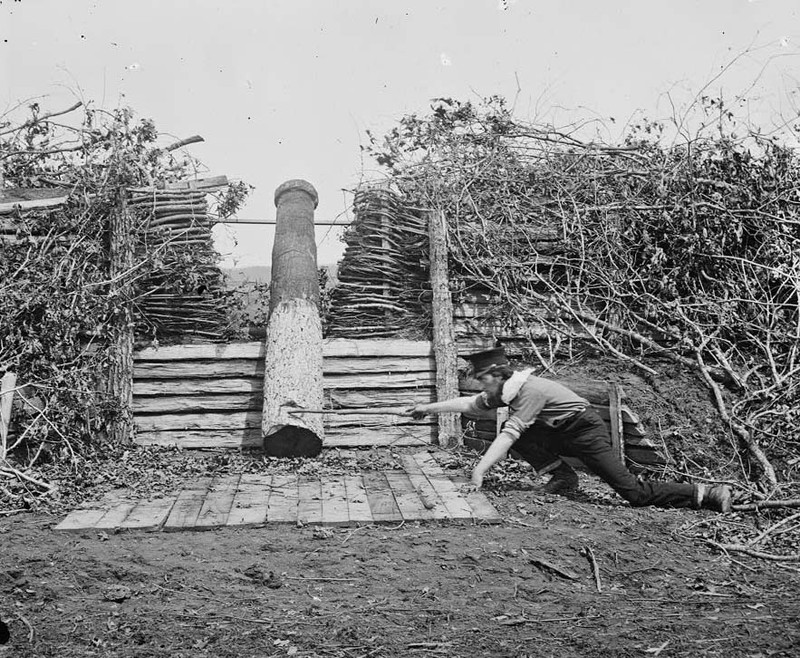
A sketch of Julia Ward Howe in Volume 2, History of Women Suffrage (1887)
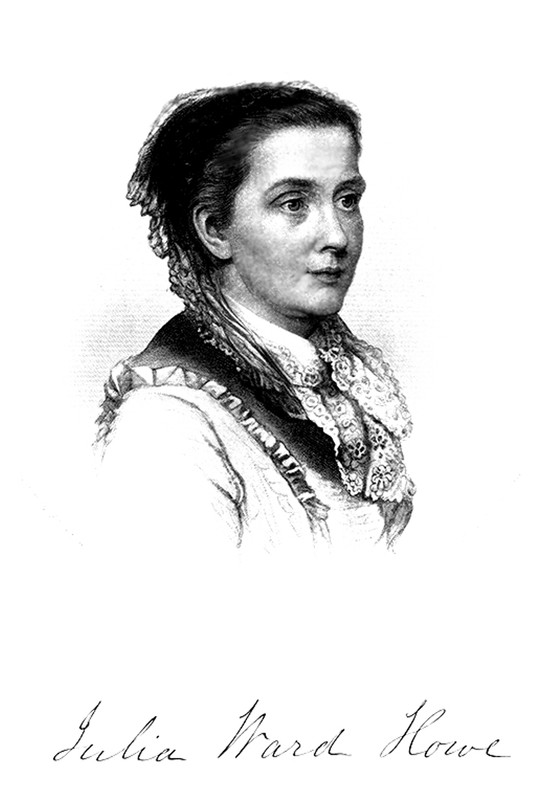
The cover of 1862 sheet music of the "Battle Hymn of the Republic"
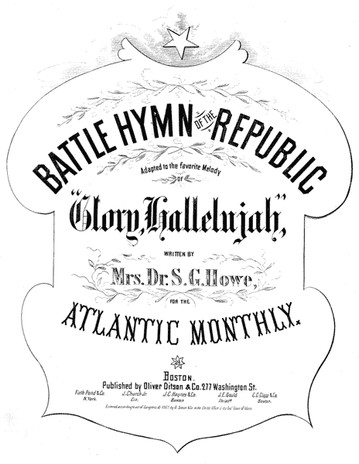
George Lincoln Rockwell, founder of the American Nazi Party
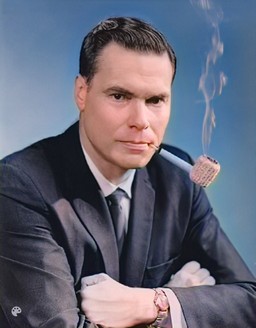
Backstory and Context
Text-to-speech Audio
Charles Horace Upton moved to Fairfax County, Virginia, from New England in 1836. His estate straddled the Fairfax County-Alexandria County line, and his home was located at what is now the northwest corner of Wilson Boulevard and McKinley Road in Seven Corners. Upton was a politicking “office seeker,” regularly moving between relatively unimportant government positions. He moved to Ohio for a short time between 1860 and 1861 to edit the Zanesville Courier newspaper, but returned to northern Virginia in early 1861. In mid-April 1861, the Virginia Convention voted to secede and ordered the suspension of upcoming Congressional elections. However, Upton, a staunch abolitionist, was not willing to abide by this order. He tried to recruit several others to run for Congress, but ultimately ran himself. The Richmond Times Dispatch opined, “Upton is ambitious but he should not abuse the patience of the people too severely.”[9] On May 23rd, 1861, he was elected to represent Virginia’s Seventh District in the US House of Representatives. The election was highly irregular, considering Confederate troops controlled much of his district and his state had seceded; only five votes were cast for him in Alexandria County. After a long, controversial investigation, his election was declared illegitimate on February 27th, 1862, and he left the House. Upton was also involved with the Second Wheeling Convention and the Restored Governments of Virginia and of Fairfax County. In 1863, President Lincoln appointed him US Consul to Switzerland, which he remained until his death in Geneva in 1877.
Upton’s Hill was an important strategic location during the Civil War. It was occupied by the Confederates in August 1861, who used it to threaten the Potomac River and Washington, after the Union loss at the First Battle of Bull Run. They built a fort, which Union forces believed to be a strong position after an attempted raid was repulsed following a heavy skirmish. When Rebel forces pulled back to Centreville – done by September 28th – however, Union troops discovered that the fortifications were stocked with “Quaker cannons” (logs painted Black). A marker was erected by the United Daughters of the Confederacy in honor of the Confederate soldiers who served there, but it was removed in 2018. (Another marker, about a skirmish between Union and Confederate troops, was damaged by a car.)
The Union held Upton’s Hill from September 28th through the end of the conflict. They constructed a series of fortifications, including Fort Upton – soon called Fort Ramsay – located around a 50-foot-tall observation and signaling tower built on top of Charles Upton’s home. The fort was constructed of stone and earth with trees pointing out on the perimeter and a moat. The tower was in line-of-sight communication with the Washington Monument and several other Union signaling posts. In building these structures, federal troops tore down Upton’s 1,400 fruit trees and generally damaged the rest of his property; he later applied for compensation but was denied.
Several slightly differing legends surround the writing of the Battle Hymn of the Republic, one of the most famous songs in American history. New York poet Julia Ward Howe, the song’s author, was the wife of a member of President Lincoln’s Military Sanitary Commission, and it is believed she was accompanying him and several others on a trip to inspect the defenses around Washington in November 1861. While at one of these posts, widely reported to be Upton’s Hill, their inspection was interrupted by a Confederate raid, which was quickly repulsed by Union troops. Sometime during the trip (possibly during the skirmish), Howe and her party heard troops singing “John Brown’s Body”, a popular, if crude and gruesome, version of the hymn “Say Brothers, Will You Meet Us?” Rev. James Clarke suggested that Howe write improved lyrics for the tune. Howe later wrote about the following morning, November 19th, 1861: “I…awoke…in the gray of the early dawn, and to my astonishment found that the wished-for lines were organizing themselves in my brain.”[13] She put them to paper, and what was christened the “Battle Hymn of the Republic” was published in the Atlantic Monthly in February 1862.
A century after the Civil War, the hill became home to an American Nazi Party “stormtrooper barracks”, earning it the nickname “Hatemonger Hill.” This house, now demolished, was located on the site of the current Upton Hill Regional Park picnic shelter. ANP founder George Lincoln Rockwell, who lived in the barracks, was assassinated in 1967 at the Dominion Hills Shopping Centre across the street. The party members moved the following year, ultimately relocating to Wisconsin in 1984.
Today, the hill is home to Upton Hill Regional Park, which offers a waterpark, miniature golf, batting cages, trails, and a shelter. It was at one time home to the world’s longest miniature golf hole – 140 feet. (Today, that record is held by a course in Cortland, New York.)
Sources
1) Battle hymn of the republic, Library of Congress. 2002. Accessed July 13th 2020. https://www.loc.gov/item/ihas.200000003/.
2) Bennett, John D.. Placenames of the Civil War: Cities, Towns, Villages, Railroad Stations, Forts, Camps, Islands, Rivers, Creeks, Fords and Ferries. McFarland, 2017. p. 83. Google Books. Accessed July 13th 2020. https://books.google.com/books?id=ppgZDgAAQBAJ.
3) Civil War Music: The Battle Hymn of the Republic; Primary Sources; Learn, American Battlefield Trust. Accessed July 13th 2020. https://www.battlefields.org/learn/primary-sources/civil-war-music-battle-hymn-republic.
4) Clark, Charles S.. Swastikas on Wilson, Arlington Magazine. August 12th 2013. Accessed July 13th 2020. https://www.arlingtonmagazine.com/swastikas-on-wilson/pic/3852/.
5) Close-Up Of An American Nazi, Northern Virginia Magazine. November 28th 2010. Accessed July 13th 2020. https://northernvirginiamag.com/culture/culture-features/2010/11/28/close-up-of-an-american-nazi-2/.
6) Colbert, Judy. Off the Beaten Path Virginia. Rowman & Littefield, 2008. p. 6. Google Books. Accessed July 13th 2020. https://books.google.com/books?id=DmL9nnVzj1EC.
7) Cortland business owners break Guinness World Record for longest 18th hole in mini golf, The Cortland Voice. August 17th 2017. Accessed July 13th 2020. https://cortlandvoice.com/2017/08/17/shipwreck-golf-owners-break-guinness-world-record-longest-18th-hole-mini-golf/.
8) History; Upton Hill Regional Park, NOVA Parks. Accessed July 13th 2020. https://www.novaparks.com/parks/upton-hill-regional-park/history.
9) Johnson, William Page, II. The Restored Government of Fairfax County. The Fare Facs Gazette: The Newsletter of Historic Fairfax City, Inc. Spring 2012. pp. 1; 3-9; 12 - 18. Historic Fairfax City, Inc. Accessed July 13th 2020. https://www.historicfairfax.org/wp-content/uploads/2012/05/HFCI92-2012.pdf.
10) Jones, Devry Becker. This Is Upton Hill!, HMdb.org. June 8th 2020. Accessed July 13th 2020. https://www.hmdb.org/m.asp?m=151009.
11) Jones, Mark. Nazis in Arlington: George Rockwell and the ANP, Boundary Stones: WETA's Local History Blog. January 2nd 2013. Accessed July 13th 2020. https://boundarystones.weta.org/2013/01/02/nazis-arlington-george-rockwell-and-anp.
12) Limbong, Andrew. Tyler-Ameen, Daoud. One Song Glory: How "The Battle Hymn of the Republic" became an anthem for every cause, NPR. July 4th 2018. Accessed July 13th 2020. https://www.npr.org/2018/07/04/625351953/one-song-glory.
13) McCollum, Sean. Battle Hymn of the Republic: The story behind the song, The Kennedy Center. September 17th 2019. Accessed July 13th 2020. https://www.kennedy-center.org/education/resources-for-educators/classroom-resources/media-and-interactives/media/music/story-behind-the-song/the-story-behind-the-song/the-battle-hymn-of-the-republic/.
14) Mahood, Wayne. General Wadsworth: The Life And Wars Of Brevet General James S. Wadsworth. Hachette Books, 2009. p. 70. Google Books. Accessed July 13th 2020. https://books.google.com/books?id=Accd8Fm0IYMC.
15) NOVA Parks. The Civil War at Upton Hill Regional Park, YouTube. March 22nd 2017. Accessed July 13th 2020. https://www.youtube.com/watch?v=6Qe7Pu06bg8.
16) Pfingsten, Bill. Swain, Craig. Vincent, Kevin. Bruton, J. Makali. Confederate Outpost, HMdb.org. July 18th 2019. Accessed July 13th 2020. https://www.hmdb.org/m.asp?m=68764.
17) Shreve, Grant. The Long, Winding History of the “Battle Hymn of the Republic”, JSTOR Daily. October 20th 2017. Accessed July 13th 2020. https://daily.jstor.org/the-long-winding-history-of-the-battle-hymn-of-the-republic/.
18) Tierney, Dominic. 'The Battle Hymn of the Republic': America's Song of Itself, The Atlantic. November 4th 2010. Accessed July 13th 2020. https://www.theatlantic.com/entertainment/archive/2010/11/the-battle-hymn-of-the-republic-americas-song-of-itself/66070/.
19) UPTON, Charles Horace (1812-1877), Biographical Directory of the United States Congress: 1774 - Present. Accessed July 13th 2020. https://bioguideretro.congress.gov/Home/MemberDetails?memIndex=U000030.
20) Waseem, Fatimah. County Removes Confederate Memorial Near Bluemont Park, ARLnow. February 1st 2018. Internet Archive Wayback Machine. February 2nd 2018. Accessed July 13th 2020. https://web.archive.org/web/20180202172548/https://www.arlnow.com/2018/02/01/county-removes-confederate-memorial-near-bluemont-park/.
edited by the author - Public Domain - Wikimedia Commons (https://commons.wikimedia.org/wiki/File:1865_Washington.jpg)
Public Domain - Wikimedia Commons (https://commons.wikimedia.org/wiki/File:Quaker_Gun2.jpg)
Public Domain - Wikimedia Commons (https://commons.wikimedia.org/wiki/File:Julia_Ward_Howe-_History_of_Woman_Suffrage_volume_2_page_793.jpg)
Public Domain - Wikimedia Commons (https://commons.wikimedia.org/wiki/File:The_Battle_Hymn_of_the_Republic_-_Project_Gutenberg_eText_21566.png)
CC0 (https://creativecommons.org/publicdomain/zero/1.0/deed.en) - Wikimedia Commons (https://commons.wikimedia.org/wiki/File:George_Lincoln_Rockwell.png)
